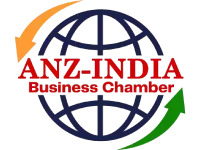Canada PR Visa: Live in Canada Permanently
Applying for a Canada PR (Permanent Residency) gives you the right to live, work, and study anywhere in Canada indefinitely, along with access to universal healthcare, social benefits, and strong legal protections. Canada is actively increasing its immigration targets to support economic growth and address labor shortages across various sectors.
Canada PR Latest Updates and Benefits for Immigrants:
- Canada to welcome 395,000 new permanent residents under skilled immigration plans
- Over 528,000 job openings available in high‑demand sectors like healthcare and technology
- PR holders enjoy free public healthcare and education up to the secondary school level
- Eligible to apply for Canadian citizenship after meeting residency requirements
- Canada strengthening immigration to boost economic growth and fill key workforce gaps
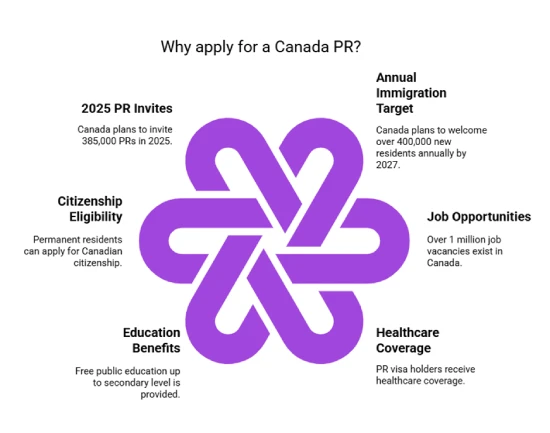
*Willing to migrate to Canada? Talk to Y-Axis to complete guidance.
What is a Canada PR Visa?
A Canada PR Visa is a document that grants permanent resident status to non-Canadian citizens. This visa is typically valid for five years and allows holders to live, work, and study freely within Canada. PR visa holders can access social benefits and may apply for Canadian citizenship after fulfilling residency requirements. The visa is renewable, and holders must maintain their permanent residence status by meeting residency obligations.
| Dos | Don’ts |
|---|---|
| Canada PRs get most of the social benefits to which Canadian citizens are entitled. These include healthcare coverage. | Canada PRs can’t vote or run for any political office. |
| Canada PRs can live, study, or work anywhere in Canada. | Canada PRs can’t hold specific government jobs requiring high-level security clearance. |
| Canada PRs can apply for Canadian citizenship. | |
| Canada PRs will be protected under the Canadian Charter of Rights and Freedoms and Canadian law. |
Types of Canada Permanent Residence Visas
- Express Entry System
- Provincial Nominee Program (PNP)
- Family Sponsorship
- Quebec-selected Skilled Workers
- Atlantic Immigration Pilot Program (AIPP)
- Caregiver Program
Pathways to Canada Permanent Residency (PR)
Canada offers multiple immigration pathways to permanent residency, each tailored to different candidate profiles such as skilled workers, families, entrepreneurs, and region-specific needs. Below are the main PR options:
Canada Express Entry (FSWP, FSTP, CEC)
What it is: A federal, points-based system that ranks candidates using the Comprehensive Ranking System (CRS) and invites the top-scoring profiles to apply for PR.
Programs in Express Entry:
- FSWP (Federal Skilled Worker Program): For skilled professionals abroad with education, work experience, and language proficiency.
- FSTP (Federal Skilled Trades Program): For certified or experienced tradespeople with a valid job offer or provincial qualification.
- CEC (Canadian Experience Class): For candidates with recent Canadian skilled work experience.
Why it’s popular: Offers fast processing (target of 6 months), frequent invitation rounds, and transparent CRS scoring.
Provincial Nominee Programs (PNPs)
What they are: Immigration programs run by Canada’s provinces and territories that nominate candidates to meet local labor market needs. A PNP nomination adds +600 CRS points in Express Entry, almost guaranteeing an invitation.
Examples of PNP Streams:
- Ontario Human Capital Priorities (HCP) Stream
- British Columbia Skills Immigration (EEBC)
- Alberta Advantage Immigration Program (Express Entry stream)
- Saskatchewan Immigrant Nominee Program (SINP) – Express Entry
- Nova Scotia Labour Market Priorities
- Manitoba Skilled Worker Stream
- New Brunswick Skilled Worker Stream
Family Sponsorship
- Who it’s for: Canadian citizens or permanent residents sponsoring eligible family members.
- Eligible relatives: Spouses/partners, dependent children, parents, and grandparents (PGP).
- Why choose it: Not CRS-based — approval depends on the sponsor’s eligibility, financial capacity, and proof of a genuine family relationship.
Pilot Pathways (e.g., Atlantic Immigration Program)
Atlantic Immigration Program (AIP): A job-offer driven pathway to attract workers to Atlantic provinces (Nova Scotia, New Brunswick, Prince Edward Island, Newfoundland & Labrador).
Other Notable Pilots:
- Rural & Northern Immigration Pilot (RNIP): For smaller communities facing labor shortages.
- Agri-Food Pilot: For workers in agriculture and food production.
- Home Child-Care Provider & Home Support Worker Programs: For in-demand caregiving roles.
CRS points breakdown
The Comprehensive Ranking System (CRS) is used under Canada’s Express Entry program to evaluate and rank candidates in the pool. Points are awarded based on factors such as age, education, language ability, work experience, and adaptability. Additional points are available for a provincial nomination, Canadian education, or a valid job offer. The maximum CRS score is 1,200 points, and candidates with the highest scores receive an Invitation to Apply (ITA) for permanent residency.
CRS Points Distribution
| CRS Category | Key Components | Max Points (Primary Candidate) | Max Points (With Spouse) |
|---|---|---|---|
| Core/Human Capital | Age, education, first official language, Canadian work experience | 500 | 460 |
| Spouse Factors | Spouse education, language, Canadian work experience | — | 40 |
| Skill Transferability | Education + language/work, foreign work + language | 100 | 100 |
| Additional Points | Provincial nomination (+600), job offer (50/200), Canadian study (15/30), French (25/50), sibling (15) | 600 | 600 |
| Total Possible CRS | 1,200 | 1,200 |
Can immigrants become Permanent Residents of Canada?
Yes, immigrants can become permanent residents of Canada if they meet eligibility criteria under various immigration programs. These include skilled workers, family sponsorship, business immigrants, refugees, and provincial nominees. Applicants must pass assessments based on factors like age, education, work experience, and language proficiency. Once granted PR status, immigrants enjoy many rights similar to Canadian citizens, except voting and holding certain government jobs.
Canadian Permanent Resident Vs. Canada Citizenship
| Aspect | Permanent Resident | Canadian Citizen |
|---|---|---|
| Right to live/work | Yes | Yes |
| Access to social benefits | Yes | Yes |
| Voting rights | No | Yes |
| Passport | No | Yes |
| Running for office | No | Yes |
| Security clearance jobs | No | Yes |
| Residency requirement | Must live in Canada at least 730 days in 5 years | Must live in Canada at least 3 years in 5 years before applying |
*Willing to check your eligibility for Canada PR? Avail Y-Axis Canada Immigration Points Calculator to check yours.
Eligibility for Canadian PR visa
Eligibility varies by program but generally includes age, education, language proficiency, work experience, and adaptability factors. Applicants must meet minimum points thresholds and other specific requirements.
Here are the eligibility criteria to apply for Canada PR visa:
- Applicants must meet minimum point’s thresholds, such as scoring at least 67 points under the Federal Skilled Worker Program.
- Language test scores are required, typically a minimum Canadian Language Benchmark (CLB) 7 on approved tests like IELTS, CELPIP, or TEF.
- Educational Credential Assessment (ECA) is needed to verify foreign education equivalence for applicants who studied outside Canada.
- Skilled work experience must be in occupations listed under the National Occupational Classification (NOC).
- Proof of funds is required to demonstrate financial ability to support initial settlement, with amounts varying by family size.
- Some programs require a Canadian job offer or provincial nomination to qualify.
- Applicants must create an Express Entry profile or apply through other streams like Provincial Nominee Programs (PNP).
Canada PR Application Document Checklist
Applicants must prepare a complete set of documents to ensure smooth processing of their Canada PR application. Below is an organized checklist grouped by category.
1. Identity & Civil Documents
- Valid passports for all applicants.
- Birth certificates.
- Marriage, divorce, or adoption certificates, if applicable.
- Recent digital photographs that meet IRCC specifications.
2. Education & Skills
- Academic degrees, diplomas, and transcripts.
- Educational Credential Assessment (ECA) report for foreign education.
- Professional licenses or trade certificates (mandatory for FSTP applicants).
3. Work & Proof of Experience
- Employer reference letters detailing duties, position, working hours, and salary.
- Employment contracts and recent pay slips.
- T4 slips or Notices of Assessment (NOAs) for Canadian work experience.
4. Language Test Results
-
IELTS, CELPIP, TEF, or TCF test results.
5. Proof of Funds (for FSWP/FSTP applicants unless exempt)
- Bank statements covering the last six months.
- Fixed deposits, investment certificates, or official letters from banks.
- Funds must be liquid and readily available.
6. Police & Medical Documents
- Police clearance certificates from all required countries.
- Upfront medical examination results from an IRCC-approved panel physician.
7. Provincial & Job Documents (if applicable)
- Provincial nomination certificate.
- Job offer, LMIA approval, or relevant employer forms, as required by the province.
8. Forms & Fees
- Completed electronic Application for Permanent Residence (e-APR).
- Government processing fees and Right of Permanent Residence Fee (RPRF).
- Biometrics payment receipts.
Canada PR Process
The Canada PR process involves several steps, including eligibility assessment, language testing, document preparation, and application submission. The process varies depending on the immigration program chosen.
How to apply for Canada PR from Australia?
Below are the Canada PR application processes:
Step 1: Complete your language proficiency tests before beginning your application. Take the IELTS exam and achieve the required scores. If applicable, you may also need to take a French language test.
Step 2: Submit your application according to the criteria of the chosen immigration program.
Step 3: Provide all necessary documents, ensuring they are authentic. Pay special attention to the authentication of your education and work experience certificates.
Step 4: Collect the required proof of funds to demonstrate your ability to support yourself in Canada. Also, complete your medical examination and obtain police clearance certificates.
Step 5: Your application and documents will be reviewed by an immigration officer. Be ready to supply any additional information if requested.
Step 6: Upon approval, you will receive confirmation of your permanent resident status along with your Confirmation of Permanent Residence (COPR) document.
Step 7: Apply for your PR card and make arrangements to travel to Canada to activate your permanent residency.
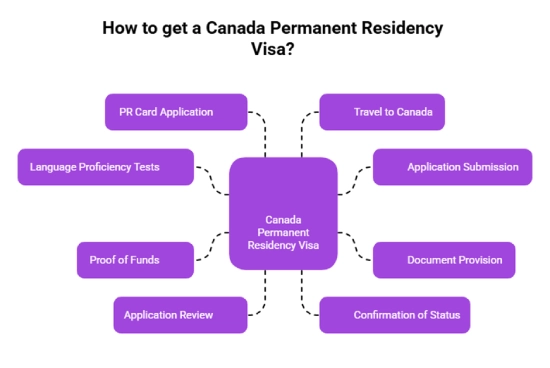
Step-by-Step Process for Canada PR through Express Entry
The journey to Canadian permanent residency follows a clear process, from checking eligibility to receiving your Confirmation of Permanent Residence (COPR). Below is a simplified timeline with approximate durations to help you plan effectively.
Step 1: Eligibility (1–3 weeks)
Confirm that you qualify under one of the pathways (FSWP, FSTP, CEC, or PNP). Book your language test (IELTS, CELPIP, or TEF) and order an Educational Credential Assessment (ECA) if your education is from outside Canada.
Step 2: Profile Creation (4–10+ weeks)
Gather your test scores and ECA results, then create your Express Entry profile online. Once submitted, your profile enters the candidate pool and is ranked via the CRS.
Step 3: Invitation to Apply (ITA) (Timing varies)
Monitor Express Entry draws. Strong CRS scores or a provincial nomination (+600 CRS) increase your chances. Once invited, you have 60 days to submit a complete application.
Step 4: Application Submission (2–6 weeks to compile)
Prepare and upload all required forms and supporting documents. Pay government fees, provide biometrics, and complete a medical exam.
Step 5: Processing to COPR (≈6–12 months)
IRCC reviews your application, verifies documents, and conducts background checks. If approved, you receive your Confirmation of Permanent Residence (COPR), allowing you to move to Canada as a permanent resident.
ECA – Educational Credential Assessment
ECA verifies that foreign educational credentials are equivalent to Canadian standards. It is required for Express Entry applicants who studied outside Canada. Designated organizations like World Education Services (WES) provide ECA reports. The ECA is valid for five years and must be submitted with the PR application.
ECA fees
ECA fees vary by organization but generally range from CAD 200 to CAD 300. Additional fees may apply for courier services or extra copies of the report.
Benefits of Canada PR
- Right to live, work, and study anywhere in Canada
- Access to healthcare and social benefits
- Protection under Canadian laws and the Canadian Charter of Rights and Freedoms
- Pathway to Canadian citizenship
- Ability to sponsor eligible family members for PR
- Access to public education and reduced tuition fees for post-secondary education
- Employment opportunities in a stable economy
High-Paying Jobs in Canada for Skilled Workers
Canada has a strong demand for skilled workers in sectors like healthcare, IT, engineering, and trades. According to Statistics Canada, over 1 million jobs are available for overseas skilled professionals. The country’s labor market is supported by immigration programs targeting in-demand occupations.
| Occupation | Average Salary in CAD |
|---|---|
| Sales Representative | 52,000 - 64,000 |
| Accountant | 63,000 - 75,000 |
| Engineering Project Manager | 74,000 - 92,000 |
| Business Analyst | 73,000 - 87,000 |
| IT Project Manager | 92,000 - 114,000 |
| Account Manager | 75,000 - 92,000 |
| Software Engineer | 83,000 - 99,000 |
| Human Resources | 59,000 - 71,000 |
| Customer Service Representative | 37,000 - 43,000 |
| Administrative Assistant | 37,000 - 46,000 |
IT Jobs in Canada
The IT sector is one of the fastest-growing in Canada, with high demand for software developers, network administrators, data analysts, and cybersecurity experts. Many IT jobs qualify under the Federal Skilled Worker Program and Canadian Experience Class.
| List of IT Jobs | NOC Codes |
|---|---|
| Developer/Programmer | NOC 21232 |
| Business System Analyst/Administrator | NOC 21221 |
| Data Analyst /Scientist | NOC 21223 |
| Quality Assurance Analyst | NOC 21222 |
| Security Analyst/Architect | NOC 21220 |
| Cloud Architect | NOC 20012 |
| IT Project Manager | NOC 21311 |
| Network Engineer | NOC 22220 |
What is the Total Cost for Canada PR Visa?
The total cost for a Canada PR visa typically ranges between CAD 2,500 and CAD 3,000, depending on the number of applicants and program fees. This includes:
- Application fees for principal applicant and dependents
- Medical examination fees
- Language test fees
- Educational Credential Assessment fees
- Police clearance certificates
- Biometrics fees
Proof of funds requirements also apply, with amounts starting at CAD 14,690 for a single applicant and increasing based on family size.
| Number of Family Members | Proof of Funds |
|---|---|
| 1 | $15,263 |
| 2 | $19,001 |
| 3 | $23,360 |
| 4 | $28,362 |
| 5 | $32,168 |
| 6 | $36,280 |
| 7 | $40,392 |
| If more than 7 people, for each additional family member | $4,112 |
Canada PR by Investment
The Canada PR visa by investment is for entrepreneurs and investors who want to contribute to the Canadian economy by establishing or investing in a business. To qualify, applicants must have a minimum net worth, make a qualifying investment, demonstrate business experience, and meet language requirements, and pass medical and security checks.
- Investment requirements vary by province through the Provincial Nominee Program (PNP), with different thresholds and criteria.
- Successful applicants receive Canadian permanent resident status, allowing them and their families to live, work, and study anywhere in Canada.
- Due to the complexity and costs involved, it is recommended to seek unbiased immigration services or consult authorized professionals to ensure compliance.
Canada PR processing time
The processing time for a Canada Permanent Residence (PR) application varies based on the type of immigration program you're applying through. Here are the estimated processing times for some of the common PR pathways:
| Type of PR Visa | Processing Time |
|---|---|
| Express Entry (Federal Skilled Worker, Federal Skilled Trades, Canadian Experience Class) | 6 to 12 months |
| Provincial Nominee Program (PNP) | 6 to 18 months |
| Family Sponsorship | 12 to 24 months |
| Quebec-selected Skilled Worker | 12 to 18 months |
| Atlantic Immigration Pilot Program (AIPP) | 6 to 12 months |
| Caregiver Program | 12 to 24 months |
Canada Draws in 2025
1,51,750 Invitations Issued in 2025
| Express Entry/Province | Jan | Feb | March | April | May | June | July | August | September | October | November | December | Total |
|---|---|---|---|---|---|---|---|---|---|---|---|---|---|
| Express Entry | 5,821 | 11,601 | 13,261 | 1,246 | 2,511 | 7,405 | 7,558 | 6,417 | 10,018 | 15,647 | 12,991 | 19,522 | 1,13,998 |
| Manitoba | 325 | 117 | 219 | 4 | 118 | 528 | 86 | 114 | 4,258 | 891 | 82 | 247 | 6,989 |
| British Columbia | 10 | NA | 13 | NA | 108 | NA | 17 | 16 | NA | 485 | 24 | 432 | 1,105 |
| Ontario | 4 | NA | NA | NA | NA | 3,791 | NA | 468 | 4,536 | 1,680 | NA | 2049 | 12,528 |
| Alberta | NA | 551 | 17 | 246 | 414 | 291 | 433 | 693 | 2,819 | 2,635 | 1,232 | NA | 9,331 |
| Prince Edward Island | 22 | 87 | 124 | NA | 168 | 52 | 39 | 132 | 129 | 319 | 190 | 179 | 1,441 |
| Newfoundland and Labrador | NA | NA | NA | 256 | 733 | NA | 509 | 433 | 570 | 225 | 330 | NA | 3,056 |
| New Brunswick | NA | NA | 498 | 477 | NA | 608 | NA | 1,052 | NA | 522 | NA | 110 | 3,302 |
| Total | 6,182 | 12,356 | 14,132 | 2,229 | 4,052 | 12,675 | 8,642 | 9,325 | 22,330 | 22,404 | 14,742 | 22,539 | 1,51,750 |
How Can Y-Axis Help You Apply for Canada PR?
Y-Axis, the world’s best overseas immigration consultancy, provides unbiased immigration services for every client based on their interests and requirements. The impeccable services of Y-Axis include:
- Free eligibility check through Canada Immigration Points Calculator
- Expert guidance/counseling for Canada Immigration
- Coaching services: Expert CELPIP coaching, IELTS proficiency Coaching
- Free career counseling; book your slot today
- Complete guidance for Canada PR visa
- Job search services to find related jobs in Canada
Looking for Inspiration
Explore what Global Citizens have to say about Y-Axis in shaping their future
Frequently Asked Questions

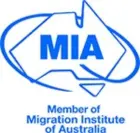
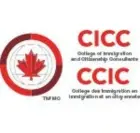

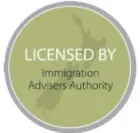
.webp)
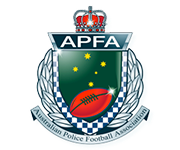
.webp)

